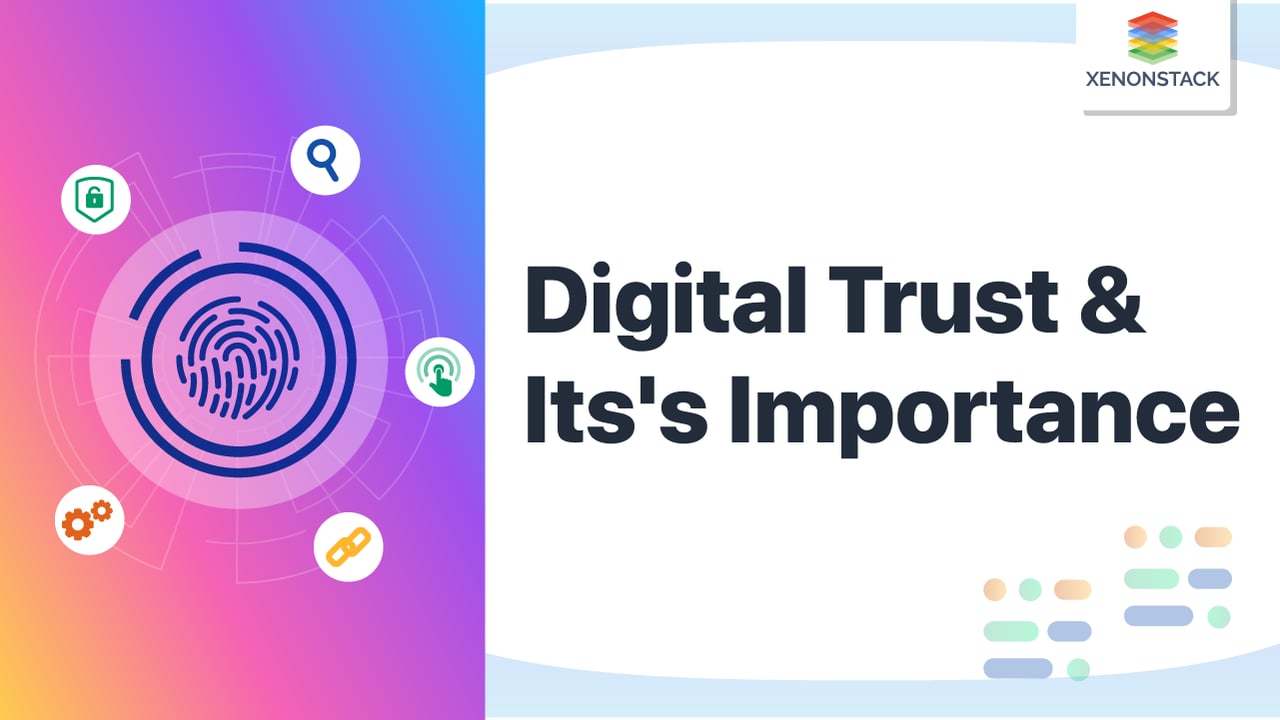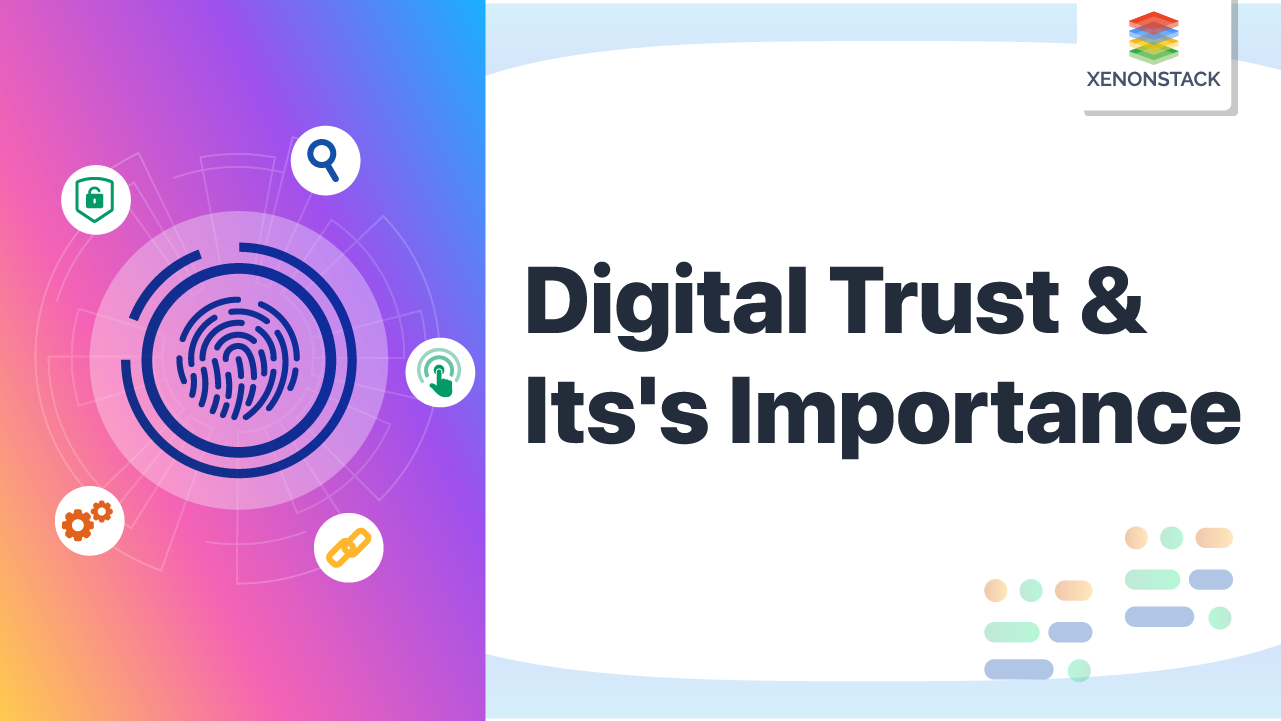
Overview of Digital Trust and Its Importance
In the interlinked world of today, when digital technologies penetrate every part of our lives, trust has become a crucial element in determining how we experience the digital world. Users want assurance that their digital interactions are secure, dependable, and privacy-respecting, whether it's cloud security challenges, online transactions, or exchanging personal information.
The idea of "digital trust"—the basis of a developing digital economy and collaborative online environments—was born out of this requirement for trust. Organizations must adopt cloud security best practices, implement strong cloud security architecture, and leverage cloud security tools and techniques to establish and maintain this trust. This blog explores the value of digital trust and strategies for fostering and preserving it in a constantly evolving digital environment.
What is Digital Trust? Key Concepts Explained
Digital trust refers to the confidence individuals, organizations, and systems have in the security, privacy, and integrity of digital technologies, interactions, and transactions. It serves as the backbone of online services, cloud-based operations, and secure digital economies.
Consumers must trust that their personal information is protected, their online transactions are secure, and their interactions with digital platforms remain reliable. Several key components of digital trust include:
-
Security – Implementing strong cloud security architecture to safeguard digital environments.
-
Privacy – Ensuring that personal data is protected across AWS Cloud Security, Azure Cloud Security, and Google Cloud Security frameworks.
-
Reliability – Providing consistent and dependable digital services while mitigating cloud security challenges.
-
Integrity – Maintaining data accuracy and preventing unauthorized modifications using Kafka Security and encryption techniques.
-
Transparency – Clear policies on cloud security tools and techniques for organizations to establish credibility.
-
Compliance – Adhering to regulatory standards and best practices in Cloud Security Analytics and Cloud Security Use Cases.
But, as per Mckinsey’s research, In many organizations, this is mainly untrue. The majority state that their companies are actively reducing a range of digital risks, including those brought on by AI models, poor data quality and retention, and a lack of diverse personnel. The majority of respondents' organizations (41 percent) minimized cybersecurity risk.
Business Impact of Digital Trust on Growth
Businesses now contact their customers more frequently because of the development of digital technologies. In order to turn a customer's experience into their satisfaction, it is crucial to make sure that these interactions are seamless.
Improved user experience increases consumer retention over time. This helps to increase the user base, which in turn accelerates the company's total growth. Let's examine some of the variables that affect how important digital trust is for business:
User Confidence
Customers are more inclined to interact and make purchases if they trust the company's digital infrastructure. A dependable, secure online network and open transaction system might help to increase confidence. For instance, consumers are more inclined to engage in e-commerce, exchange personal information, and complete online transactions when they trust digital platforms, which ultimately promotes economic growth and innovation.
Brand Reputation and Value
The reputation and brand perception of a company is directly impacted by digital trust. Businesses gain credibility as trustworthy and reliable entities by prioritizing and establishing strong security measures, open data practices, and dependable services. Positive brand perception improves consumer perception, draws in new users, and helps firms stand out in a crowded digital market. Improved digital trust can boost a company's reputation and boost its brand image. Customers are more inclined to prefer a company if they have faith in its digital effectiveness.
Data Sharing and Collaboration
In digital ecosystems, collaboration and data exchange depend on trust. When organizations and individuals believe that their information will be treated securely, morally, and in accordance with privacy laws, they are more ready to give insightful data and analysis. Cooperation, knowledge sharing, and group problem-solving are made possible by trust, which stimulates innovation and advancement.
Data Security and Risk Mitigation
Security and risk reduction go hand in hand with digital trust. Organizations can reduce the risk of data breaches, cyberattacks, and financial losses by putting money into strong security measures and valuing user privacy. A more secure digital environment is achieved via the deployment of trustworthy systems and procedures that increase user protection and decrease vulnerabilities.
Economic Growth
Digital transformation and economic growth are both accelerated by digital trust. Users are more inclined to accept digitalization and engage in the digital economy when they have faith in digital technologies and services. A rise in user confidence leads to better adoption rates, more online sales, and the introduction of new business models, all of which foster innovation and economic growth.
Regulatory Compliance
Compliance with legal requirements and regulatory requirements is directly related to building trust. By displaying their dedication to abiding by pertinent rules and regulations, businesses that place a high priority on data protection, privacy, and security gain the trust of their customers. Compliance boosts user assurance while shielding businesses from legal and reputational threats.
Essential Steps to Build Digital Trust Effectively
Digital Trust integration in business can assist the organization in a variety of ways. It not only boosts business growth but also increases customer happiness and loyalty within the organization. The following are some key steps of how digital trust can be developed in businesses:
Prioritize Security
Implement robust security measures, such as encryption, firewalls, and intrusion detection systems, to protect digital assets and user data from cyber threats. Conduct regular security audits and vulnerability assessments to identify and address potential weaknesses. Stay updated with the latest security practices and technologies to ensure the highest level of protection.
Respect Privacy
Develop transparent and user-friendly privacy policies that clearly explain how data is collected, used, and shared. Obtain informed consent from users before collecting their personal information and allow them to control their data preferences. Anonymize or pseudonymize data when possible to protect user identities.
Ensure Data Integrity
Implement measures to maintain data accuracy, reliability, and consistency during digital transactions. Utilize data validation techniques to verify the integrity of information exchanged between systems. Use digital signatures and secure data transmission protocols to prevent unauthorized alterations or tampering.
Focus on Reliability
Design systems and services to be highly reliable, minimizing downtime and service disruptions. Provide clear communication channels and responsive customer support to address user concerns promptly. Regularly test and monitor system performance to maintain consistent and dependable user experiences.
Foster Transparency
Be transparent about data handling practices, security measures, and privacy policies. Clearly communicate the purpose and intended use of user data, as well as any third-party sharing. Provide accessible information to help users make informed decisions and understand how their data is being utilized.
Ensure Regulatory Compliance
Stay up-to-date with applicable laws, regulations, and industry standards related to data protection and privacy. Comply with legal obligations and demonstrate a commitment to ethical behavior. Regularly review and update policies and procedures to align with changing regulatory landscapes.
Empower Users
Educate users about digital security best practices, such as strong passwords, phishing awareness, and safe online behavior. Offer user-friendly privacy settings and controls, allowing individuals to customize their preferences and manage their data. Provide transparency reports or dashboards that enable users to view and track their data usage.
Build Trustworthy Partnerships
Collaborate with trusted partners and service providers with established track records in data security and privacy. Perform due diligence when selecting third-party vendors to ensure they adhere to similar trust-building practices.
Engage in Responsible Data Practices
Only collect and retain data that is necessary for the intended purpose, minimizing data exposure and potential risks. Regularly review and update data handling practices to align with evolving privacy standards. Conduct privacy impact assessments to evaluate and address potential privacy risks.
Navigating Data Ethics and Adaptive Governance Strategies
Organizations must become skilled in dealing with grey zones and a continuously evolving landscape. They'll have to strike a balance between how they collect and utilize data and the societal ramifications of their actions - and understand that the line is continuously shifting. They'll need to include a lot of flexibility in their data techniques and models. They'll also need to provide a foundation of values to guide compliance, governance, and ethical decision-making. This takes us back to the necessity for a design overhaul.
Next Steps for Implementing Digital Trust Measures
Talk to our experts about implementing digital trust solutions, how industries and different departments use secure Agentic Workflows and trust-driven Decision Intelligence to become decision-centric. Utilize AI to automate and optimize IT support and operations, improving efficiency and security.


